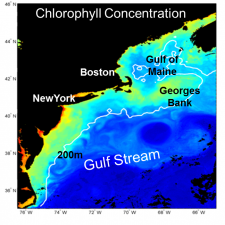Circulation & Biogeochemistry
A Circulation, Mixing, and Growth Machine
The dramatic richness of the coastal oceans is due in part to their dynamic physical and biological nature—a multitude of species and critical ecosystem functions interacting with one another to sustain life. On the coasts, processes are driven by complex internal dynamics as well as by interactions with the open ocean, the ocean floor, and the coastlines themselves.
The coasts are also subject to strong intermittent forcing from the atmosphere. Waves and tides produce local mixing and stirring that keep everything in a constant state of flux. Coastal winds cause upwelling of cold, nutrient-rich waters along the coasts, helping to support some of the most productive fisheries on the planet.
Coastal study requires a sophisticated understanding of closely coupled biological-chemical-physical processes, ranging in scale from individual organisms to the larger coastal-scale environment in which they are embedded.
Key Coastal Ecosystems
The services provided by coastal ecosystems— food, fiber, and water purification—are dependent on the types of organisms that comprise them. For example, through photosynthesis, ocean microbes provide all the organic matter that forms the base of the food webs that ultimately feed humans.
Yet, we do not fully understand how the diversity of organisms comprising food webs influences the flow of energy and matter through them. The coastal oceans are thus interesting from a biogeochemical and population dynamics perspective as well.
Future progress in physical, biogeochemical, and ecosystem coastal oceanography requires new emphasis on interactions both within and between the physical, chemical, and biological domains at multiple temporal and spatial scales. New sensors, platforms, and sampling schemes are needed to capture such multiscale interdisciplinary cycles. Process studies as well as realistic modeling systems are needed to quantify and predict these cycles and interactions.
Key Questions We’re Exploring
- How important are the coastal oceans for the global carbon cycle?
- How are chemicals, both natural (e.g. salts from rivers) and man-made (e.g. lead and mercury) accommodated and transformed by coastal ecosystems?
- To what extent do coastal ecological communities assemble according to specific and thus predictable rules? How do these rules relate to biogeochemical function in coastal ecosystems?
- How do coastal assemblages and networks in communities affect the flow of energy and matter through them?
- What sensors and platforms are needed to quantify key controls on the biological productivity of coastal ecosystems?
- How can we best combine data from sensors and observation systems with models to enhance our predictive powers of coastal ecosystem variability and change?
–







